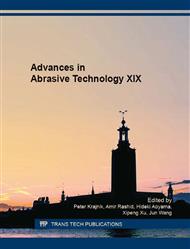p.172
p.178
p.187
p.193
p.199
p.205
p.213
p.219
p.227
Preparation and Test of Conventional Composite Abrasives Using Recycled Alumina Grains
Abstract:
In this work we report the preparation and evaluation of the mechanical characteristics of resin-bond composite abrasives using virgin and recycled alumina grains. The composite abrasives were made with phenolic resin as binder and as-received virgin and recycled alumina grains. Three different recycled alumina grains were studied: i) alumina from wood firing resin-bond abrasive tools; ii) alumina from wood firing vitrified-matrix abrasive tools; and iii) ground alumina from vitrified-matrix abrasive tools. The virgin alumina grains were employed in order to compare the mechanical performance of the prepared composite abrasive. The composition of alumina grains, analyzed by X-ray fluorescence spectroscopy revealed the recycled alumina grains have lower alumina content and higher concentration of silica in vitrified-matrix abrasives samples. The sand blast penetration tests have shown lower penetration depth in the virgin and the ground vitrified-matrix grains composites. The impact strength test results revealed its dependence on the alumina and silica content: samples with higher alumina content present the higher impact resistance whereas samples with higher silica content present lower impact strength.
Info:
Periodical:
Pages:
199-204
Citation:
Online since:
October 2016
Keywords:
Price:
Сopyright:
© 2016 Trans Tech Publications Ltd. All Rights Reserved
Share:
Citation:


